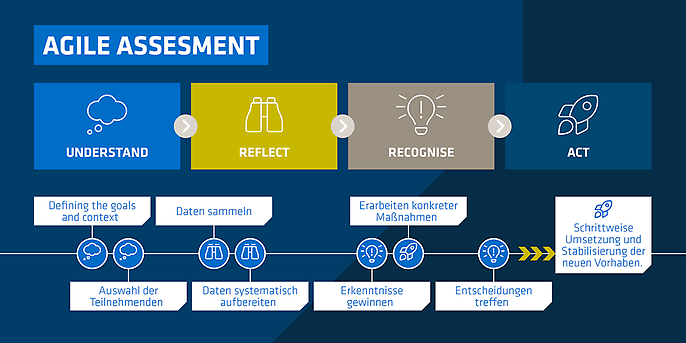11. October 2022 By Henrik Stapel
Making agility measurable and further developing your organisation – adesso’s Agile Assessment
At the beginning of 2020, it was hardly imaginable that companies could complete a large portion of their projects using teams that collaborate remotely. In 2022, working from home and using online tools to work on projects is normal everyday life for many people. New forms of work, new business models, new challenges – once again, changes in companies and also in their environment are being greatly accelerated.
Managers and decision-makers can either watch as this momentum takes their companies by surprise, or they can deliberately use agile methods to actively shape the transformation.
That being said, agile initiatives rarely start without prior experience these days. Meanwhile, many companies have already gained initial experience with agile methods; however, in an organisation that wants to create extensive change, not every step can be planned precisely. How the people in a company will behave during this process cannot be predicted. From my point of view, straying from the path is sometimes part of the process. We have learned from a wide range of projects that in agile transformations the question always arises as to the current state of an organisation’s agile efforts. Are we still on the right track? What new influencing factors need to be taken into account? How do we ultimately manage to coordinate internal and external dependencies in a goal-oriented way? Does the chosen agile framework still fit? What cultural aspects do we need to consider? How do we get our employees on board?
In order to be able to answer these questions together with our customers, a working group from adesso’s Agile Community of Practice has developed an interactive format for tracking agile teams and organisations – adesso’s Agile Assessment.
adesso’s Agile Assessment – characteristics and added value
adesso’s Agile Assessment is a multi-layered workshop format that helps companies assess how far previous efforts have already taken the organisation and for which topics there is a need to take action.
The format is characterised by the fact that time is taken to honestly reflect on previous experiences and to be able to openly identify current fields of action – all as part of an organised procedure. With this as a basis, concrete measures and a vision for the next steps to take along the agile journey can be developed together in accordance with the adesso approach. The main focus is always on goals and strategies.
This enables us to help companies orient themselves during their agile transformations, and the benefits of agility for the context at hand become apparent. Anchor points are also highlighted, the tracking of which makes it possible to measure the success of an agile approach. The added value comes from the discussions and exchanges between different levels in a company.
adesso’s Agile Assessment can be adapted to our customers’ individual setups and offers solutions for different levels: the needs of operational product teams can be addressed, and the importance of agile aspects at the strategic and coordinating levels can be examined from the proper angles. This empowers all levels to work out concrete development opportunities in accordance with the challenges at hand and in accordance with the corporate strategy.
adesso’s Agile Assessment examines three aspects of agility in a company:
- 1. In the aspect ‘working agilely’, questions about processes, structure and technology are discussed.
- 2. When working on the aspect ‘being agile’, culture, values and leadership come to the fore.
- 3. Strategy, customer orientation and product are examined in the aspect ‘agile orientation’.
Process model
Collecting data in order to understand the status quo is the basis for the discussion about agility in a company. adesso’s Agile Assessment uses questionnaires that are developed specifically for this purpose. Depending on the context, these can be processed using tools such Microsoft Forms or serve as the basis for interviews.
The identified findings and deviations from the norm are systematically processed and serve to reflect the current level of maturity in accordance with our adesso model. The Agile Assessment Interaction Room was developed to make it so that the current challenges can be discussed in a way that is structured and to gain insights from the collected data.
Targeted DIE moderation is used to focus communication on the aspects that are critical to success. Outlining interrelationships in the company creates clarity and promotes the early identification and elimination of uncertainties and risks via intuitive visualisation.

Process Model Agile Assessment by adesso
All of this helps to derive concrete measures in a way that is structured and creates a transparent basis for decision-making for the company to use in order to continue navigating along its agile journey.
Outlook
adesso’s Agile Assessment offers a clear assessment of the current situation and creates awareness for the upcoming measures at all levels. adesso offers strategic and operational support during the implementation process in order to help you take action and bring your vision to life.
Part of the agile community’s service portfolio includes things such as help selecting suitable scaling frameworks and support for your agile transformation. Helping manage changes in the company by (agilely) coaching decision-makers as well as using experienced Scrum Masters to consult and support product teams promotes the acceptance of the measures just as much as it does when several agile teams work in coordination with one another.
You will find more exciting topics from the adesso world in our latest blog posts.

